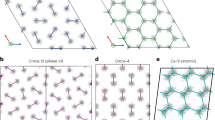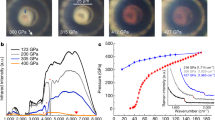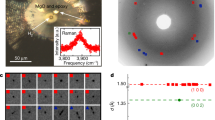Abstract
The possibility that steadily compressed hydrogen might undergo a transition from a proton-paired insulator to a monatomic metal was first suggested in 1935 (ref. 1). But experimental realization of metallic hydrogen in solid form has remained elusive, despite studies at pressures as high as 342 GPa (ref. 2). The pairing structure is known to be robust (from the persistence of its associated vibron mode3), leading to the suggestion of an alternative route to the metallic state, involving a band-overlap transition in which the pairing is preserved4. Here we report density functional calculations within the local density approximation that predict a range of densities for hydrogen where a paired or molecular metallic state may be energetically preferred. The transition to this metallic state is naturally associated with the closing of an overall bandgap; but the pressures required to effect the transition are shown to change significantly when the gaps are corrected by approximate inclusion of many-electron effects. The implication is that a complete resolution of the structural and phase problem in dense hydrogen may require methods beyond the local density approximation.
This is a preview of subscription content, access via your institution
Access options
Subscribe to this journal
Receive 51 print issues and online access
$199.00 per year
only $3.90 per issue
Buy this article
- Purchase on Springer Link
- Instant access to full article PDF
Prices may be subject to local taxes which are calculated during checkout



Similar content being viewed by others
References
Wigner, E. & Huntington, H. B. On the possibility of a metallic modification of hydrogen. J. Chem. Phys. 3, 764–770 (1935).
Narayana, C., Luo, H., Orloff, J. & Ruoff, A. L. Solid hydrogen at 342 GPa: no evidence for an alkali metal. Nature 393, 46–49 (1998).
Hemley, R. J. & Mao, H. K. Phase transitions in solid molecular hydrogen at ultrahigh pressures. Phys. Rev. Lett. 61, 857–860 (1988).
Barbee, T. W., Garcia, A., Cohen, M. L. & Martins, J. L. Theory of high-pressure phases of hydrogen. Phys. Rev. Lett. 62, 1150–1153 (1989).
Kaxiras, E., Broughton, J. & Hemley, R. J. Onset of metallization and related transitions in solid hydrogen. Phys. Rev. Lett. 67, 1138–1141 (1991).
Nagao, K., Nagara, H. & Matsubara, S. Structures of hydrogen at megabar pressures. Phys. Rev. B 56, 2295–2298 (1997).
Mazin, I. I. & Cohen, R. E. Insulator-metal transition in solid hydrogen: implications of electronic-structure calculations for recent experiments. Phys. Rev. B 52, R8597–R8600 (1995).
Edwards, B. & Ashcroft, N. W. Spontaneous polarization in dense hydrogen. Nature 388, 652–655 (1997).
Edwards, B., Ashcroft, N. W. & Lenosky, T. Layering transitions and the structure of dense hydrogen. Europhys. Lett. 34, 519–524 (1996).
Ceperley, D. M. & Alder, B. J. Ground state of solid hydrogen at high pressures. Phys. Rev. B 36, 2092–2106 (1987).
Natoli, V., Martin, R. M. & Ceperley, D. M. Crystal structure of atomic hydrogen. Phys. Rev. Lett. 70, 1952–1955 (1993); Crystal structure of molecular hydrogen at high pressures. Phys. Rev. Lett. 74, 1601–1604 (1995).
Kohanoff, J., Scandolo, S., Chiarotti, G. L. & Tosatti, E. Solid molecular hydrogen: the broken symmetry phase. Phys. Rev. Lett. 78, 2783–2786 (1997).
Hanfland, M., Hemley, R. J. & Mao, H. Novel infrared vibron absorption of solid hydrogen at megabar pressures. Phys. Rev. Lett. 70, 3760–3763 (1993).
Eggert, E. H. et al. Absorption and reflectance in hydrogen up to 230 GPa: implications for metallization. Phys. Rev. Lett. 66, 193–196 (1991).
Edwards, B. Solid Hydrogen at High Pressures. Thesis, Cornell Univ. (1997).
Mazin, I. I., Hemley, R. J., Goncharov, A. F., Hanfland, M. & Mao, H.-K. Quantum and classical orientational ordering in solid hydrogen. Phys. Rev. Lett. 78, 1066–1069 (1997).
Kohanoff, J., Scardalo, S., de Gironcoli, S. & Tosatti, E. Dipole-quadrupole interactions and the nature of Phase III of compressed hydrogen. Phys. Rev. Lett. 83, 4097–4100 (1999).
Loubeyre, P. et al. X-ray diffraction and equation of state of hydrogen at megabar pressures. Nature 383, 702–704 (1996).
Evans, W. J. & Silvera, I. F. Index of refraction, polarizability, and equation of state of solid molecular hydrogen. Phys. Rev. B 57, 14105–14109 (1998).
Hedin, L. New method for calculating the one-particle Green's function and application to the electron-gas problem. Phys. Rev. 139, A796–A823 (1965).
Chacham, H. & Louie, S. G. Metallization of solid hydrogen at megabar pressures; a first-principles quasi particle study. Phys. Rev. Lett. 66, 64–67 (1991).
Johnson, K. A. & Ashcroft, N. W. Corrections to density-functional theory band gaps. Phys. Rev. B 58, 15548–15546 (1998).
Sterne, P. A. & Inkson, J. C. Exchange-correlation potential in semi-conductors and insulators. J. Phys. C 17, 1497–1510 (1984).
Ruoff, A. L. & Ghandehari, K. The refractive index of hydrogen as a function of pressure. Mod. Phys. Lett. B 7, 907–911 (1993).
Hemley, J. R., Hanfland, M. & Mao, H. K. High pressure dielectric measurements of solid hydrogen to 170 GPa. Nature 350, 488–491 (1991).
Straus, D. M. & Ashcroft, N. W. Self-consistent structure of metallic hydrogen. Phys. Rev. Lett. 38, 415–418 (1997).
Richardson, C. F. & Ashcroft, N. W. High temperature superconductivity in metallic hydrogen; electron-electron enhancements. Phys. Rev. Lett. 78, 118–121 (1997).
Kresse, G. & Hafner, J. Efficient iterative schemes for ab initio total energy calculations using a plane-wave basis set. Phys. Rev. B 54, 11169–11186 (1996).
Vanderbilt, D. Soft self-consistent pseudopotentials in a generalized eigenvalue formalism. Phys. Rev. B 41, 7892–7895 (1990).
Johnson, K. Electronic Structure, Band-gaps, and the Insulator-metal Transition in Solid Hydrogen. Thesis, Cornell Univ. (1998).
Acknowledgements
The results we report here were obtained using both the Vienna Ab-Initio Simulation Package authored by G. Kresse, J. Furthmüller and J. Hafner and the Corning Planewave code made available by M. Teter. We thank the Cornell Center for Materials Research for computing facilities. This work was supported by the US NSF.
Author information
Authors and Affiliations
Corresponding author
Rights and permissions
About this article
Cite this article
Johnson, K., Ashcroft, N. Structure and bandgap closure in dense hydrogen. Nature 403, 632–635 (2000). https://doi.org/10.1038/35001024
Received:
Accepted:
Issue Date:
DOI: https://doi.org/10.1038/35001024
This article is cited by
-
Synchrotron infrared spectroscopic evidence of the probable transition to metal hydrogen
Nature (2020)
-
Semimetallic molecular hydrogen at pressure above 350 GPa
Nature Physics (2019)
-
A comparative study using state-of-the-art electronic structure theories on solid hydrogen phases under high pressures
npj Computational Materials (2019)
-
Liquid hydrogen at the thermodynamic conditions of room temperature and a pressure of 490 GPa
Bulletin of Materials Science (2019)
-
Anomalous bond length behavior and a new solid phase of bromine under pressure
Scientific Reports (2016)
Comments
By submitting a comment you agree to abide by our Terms and Community Guidelines. If you find something abusive or that does not comply with our terms or guidelines please flag it as inappropriate.



